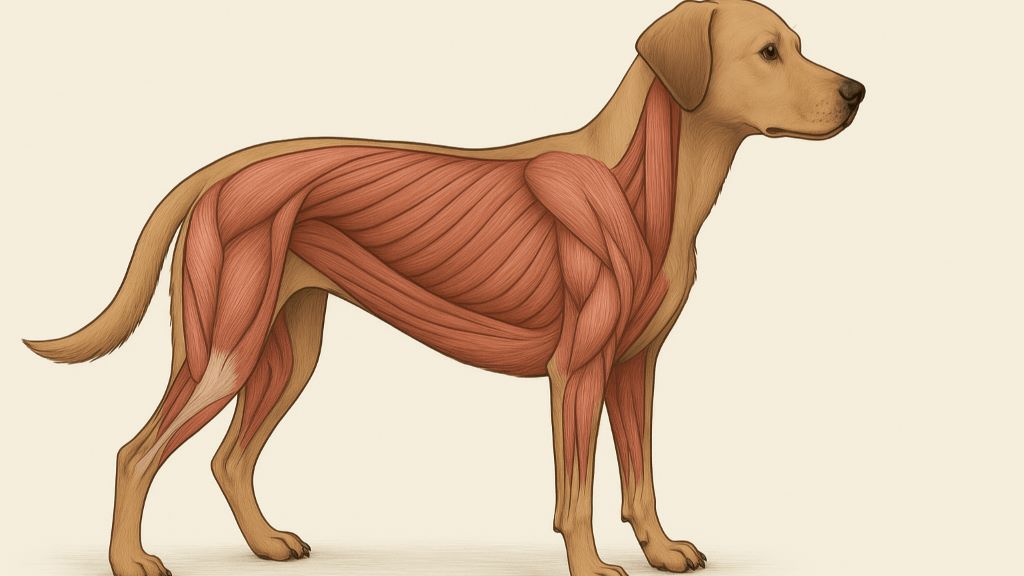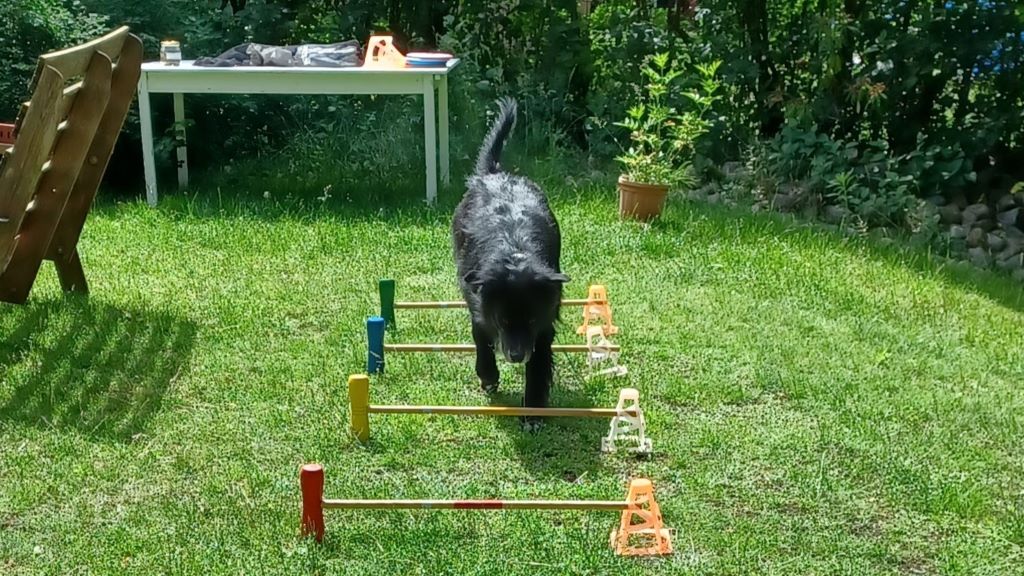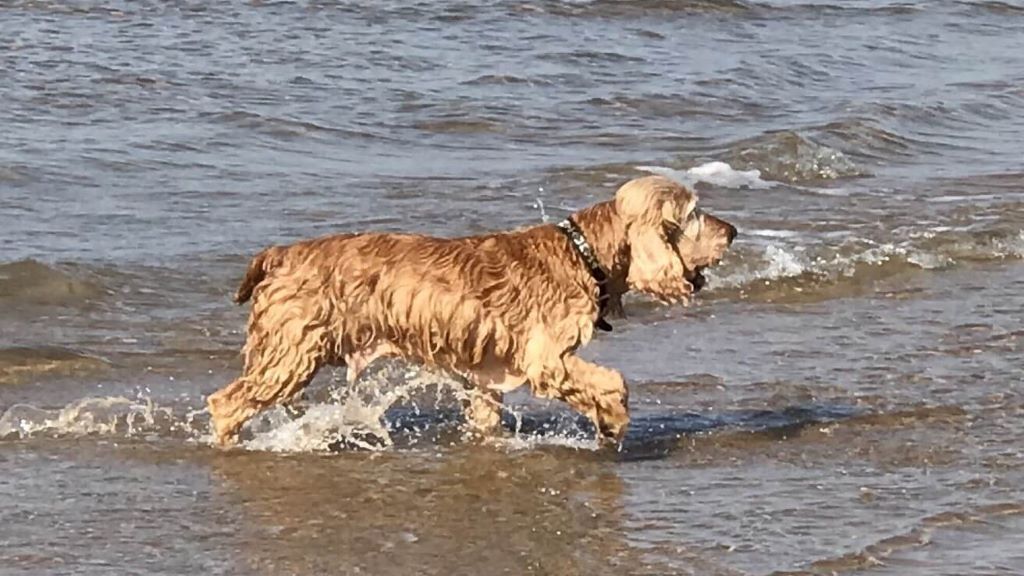Walking for Dogs Benefits: Easy Way to Strengthen Your Dog

Walking for Dogs Benefits Strength & Stability
Why Walking is More Than Just Moving Forward
Many of my clients are surprised when I talk about how walking for dogs benefits their functional health. They often tell me it seems too simple or boring, and some say their dog can’t walk anyway. But once they understand how much it strengthens a dog’s body, they see it in a whole new way. And after trying it for a while, they start to notice a difference. When done with intention, walking becomes an effective but low-intensity strength training for dogs.
So, let us look at the gait trotting. In the wild, wolves rely on trotting as their primary gait. So why is that? Trotting is highly efficient because it takes advantage of the elastic energy stored in their tendons, which allows them to move forward with much less muscular effort. Many dogs naturally prefer trotting too—it’s faster and simply helps save energy.
Research from the Journal of Experimental Biology (2017) confirms that dogs, like wolves, utilize elastic energy storage in their tendons, making trotting an efficient and energy-saving gait. No wonder they choose trotting! However, while trotting saves energy, walking requires more controlled movement and engages the stabilizing muscles more intensely. So, let's take a closer look at the benefits of walking.
How Walking for Dogs Benefits Deeper Muscle Engagement
Unlike trotting, walking is a four-beat gait where three legs remain on the ground at all times. In trotting, which is a two-beat gait, there is a suspended phase where all four feet leave the ground for a short moment. So, because walking lacks this suspended phase, forward movement becomes heavier and requires more effort, therefore, activating stabilizing muscles that support balance and coordination. This is why walking is an excellent tool for strength training, injury prevention, and overall fitness. Unfortunately, we see many dogs in the clinic that don't even know how to walk.
Walking for Dogs Benefits Joint Health & Injury Prevention
What Science Says About Walking & Joint Stability
So, even though walking may not seem as dynamic as trotting, it challenges the body differently. The slower, more controlled movement activates those important stabilizing muscles that are helping your dog maintain its balance and coordination.
Let us see what the research says! Just as I mentioned, studies show that when dogs walk more slowly, their muscles have to work harder to stay stable.
Research from ResearchGate (2004) found that slower walking speeds increase the activation of muscles like the Rectus femoris and Biceps femoris, which are essential for stabilizing the knee joint.
Building on this, a 2021 study from MDPI further confirmed that slow walking leads to greater co-activation (simultaneous activation of muscles) of the muscles around the knee, improving joint support and reducing the risk of injury.
Another study in the Journal of Experimental Biology also found that a dog's back muscles (epaxial muscles) are actively engaged during walking. These muscles, particularly the multifidus and longissimus, help the dog stay balanced by controlling side-to-side movement and reducing twisting forces along the spine.
How Walking for Dogs Benefits Long-Term Joint Health
- Walking isn't just about moving forward—it engages the core and back muscles to keep the body stable.
- The more controlled and intentional the walk, the more these muscles work to support posture and movement.
- Slow, steady walks are a simple but powerful way to strengthen a dog’s core and spinal stability over time.

How Walking Strenghtens a Dog's Core & Spine
Why Core Strength Matters for Your Dog
Walking is a simple but very effective way to build strength in dogs. Often we see dogs in rehabilitation struggling with poor stability. Walking helps improve both stability and coordination while being gentle on the joints— unfortunately, it's often undervalued and overlooked. That's why it's worth practicing with your dog. With each step, the muscles work a little longer to support the body’s weight compared to faster gaits like trotting. This controlled movement helps improve endurance and stability without putting too much strain on the body.
Unlike trotting, where movement is more direct and energy-efficient, walking involves more side-to-side motion in the spine. This means the stabilizing muscles along the back and core have to work harder to maintain balance and coordination. Because of this, walking is beneficial for all dogs, whether it is older dogs, those recovering from injuries, young dogs still developing proper movement patterns, or any dog at any age for injury prevention and low-impact exercise.
Since walking is low-impact, it’s easy to include it in a dog’s daily routine. By varying the walking surface – such as grass, sand, or gentle inclines – it helps to activate different muscles and makes the training even more effective. Small adjustments like these can go a long way in keeping dogs strong, stable, and moving well throughout their lives.

Maximizing Walking for Dogs Benefits with Simple Adjustments
Small Changes That Make a Big Difference
- Walk on varied terrain (grass, sand, gravel) to increase muscle engagement.
- Use slight inclines or hills to challenge strength and endurance.
- Control the walking pace to focus on slow, intentional movement rather than rushing.
- Use obstacles such as cavaletti poles, or for some dogs, a ladder laid flat on the ground can do the trick. If the spacing between the rungs suits the dog, it’s an excellent and simple way to train. Many people already have a ladder at home that they can place in the yard.
Fun Ways to Make Walks More Engaging
Walking doesn’t have to be the same every day. Adding small variations can make it more enjoyable for both you and your dog while also providing extra physical and mental benefits.
One simple way to switch things up is to walk in serpentines—weaving between trees, posts, or cones instead of walking in straight lines. This helps your dog shift their weight, engage their core, and improve coordination. It also encourages better body awareness and balance, which is great for injury prevention.
Another great way to add variety is to let our dogs sniff and explore scents along the way. It’s easy to get impatient when they stop to sniff everything, but sniffing is how they explore and make sense of the world—it’s important to them. So why not turn it into a fun activity? Try hiding small treats along the path or using a favorite scent to guide them. If your dog enjoys tracking, this is a great way to add variety to the walks and keep them mentally stimulated.
By making these small changes, you can keep walks interesting while also supporting your dog’s strength, coordination, and overall well-being.

Final Thoughts
If you want to improve your dog’s balance and strength, remember that walking plays a key role in their overall physical health. While trotting is an efficient way for dogs to move, slow and controlled walking engages muscles in a different way, helping to build stability, strength, and coordination. However, to get the most out of your walks, it’s important to mix up the gaits. Trotting is great for strengthening the core and back muscles while walking focuses on balance and controlled movement. Together, they complement each other and provide well-rounded exercise for your dog.
When introducing these exercises, start small. I often recommend beginning with 20-30 meters of focused walking, sometimes even less if your dog is older, recovering from an injury, or just starting out. Gradually increasing the distance and alternating between walking and trotting helps build strength and endurance in a safe and controlled way.
As you walk your dog, pay attention to how they move. Find their natural rhythm to encourage proper movement patterns and avoid pacing, where both legs on one side move together instead of in a diagonal pattern. Small adjustments like these can make a big difference in how effectively your dog engages their muscles.
By making these small changes to your daily walks, you not only help your dog stay fit and strong but make the walk more engaging for both of you.
Want to experience how terrain changes muscle engagement? Try to first walk on a flat surface, and then walk on the edge of the grass. Feel the difference in how much more you have to lift your legs and adjust your balance. So a small change like this, adds quite a bit of variety to your dog's walk and also helps to strengthen stabilizing muscles naturally.
Simple Takeaway - Walking vs. Trotting
- Trotting = Stability & Core Strength – Helps keep the back stable, absorbs impact, and strengthens core muscles for efficient movement.
- Walking = Flexibility & Control – Involves more side-to-side movement, requiring stabilizing muscles to work harder for balance and spinal support.
- Why does this matter? A mix of both gaits strengthens your dog’s back and core in different ways, improving stability, flexibility, and injury prevention. And if your dog ever needs to stick to just walking—due to aging, recovery, or rehabilitation—you now know how effective it can be for maintaining strength, balance, and overall fitness.
Walking is a great way to support your dog’s strength and physical health, but understanding how they move is just as important as keeping them active. To learn more about your dog’s well-being and how to recognize signs of discomfort that might go unnoticed, read on to discover how to spot hidden pain and what to do about it.
🐾 Keep Your Dog Moving Strong & Injury-Free
💡 Join my mailing list and get expert tips on dog wellness, injury prevention, and fitness—straight to your inbox! Learn how to spot early signs of discomfort, protect your dog’s joints, and build simple daily routines to keep them active for years to come.
- Exclusive articles & early access to new resources
- Simple daily routines to support strength & mobility
- Easy ways to prevent joint issues & movement problems
- Hands-on techniques to keep your dog active with confidence
🐾 Sign up today and start making a difference for your dog’s health and happiness!
Start Your Daily Routines Today!